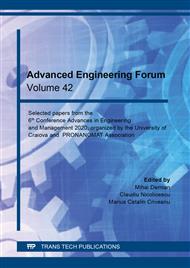[1]
Information on Integrated Environmental Permit, Information on http://www.anpm.ro/ documents/24783/11973856/AM+Integrata+6+-+2015+CARPATCEMENT+HOLDING+ SA.PDF/585e059d-c2a2-4706-a009-3b7b3dfdf3c9.
Google Scholar
[2]
J.O. Anderson, J.G. Thundiyi, A. Stolbach, Clearing the air: a review of the effects of particulate matter air pollution on human health, J. Med. Toxicol., 8(2) (2012) 166-175.
DOI: 10.1007/s13181-011-0203-1
Google Scholar
[3]
C. Sescu-Gal, G.P. Zafiu, Characterization of polluting emissions from cement factories. Their influences on the environment and human beings (in Romanian), XIXnd National Symposium of Construction Equipment SINUC 2013", (2013), 8 pages, Information on https://scholar.google.com/citations,user=JAjEaBgAAAAJ&hl=en.
Google Scholar
[4]
F.R. Cassee, M.E. Héroux, M.E. Gerlofs-Nijland, F.J. Kelly, Particulate matter beyond mass: recent health evidence on the role of fractions, chemical constituents and sources of emission, Inhalation Toxicology, 25 (2013) 802-812.
DOI: 10.3109/08958378.2013.850127
Google Scholar
[5]
E. Kalafatoglu, N. Ors, S.S. Ozdemir, I. Munlafalioglu, Trace element emissions from some cement plants in Turkey, Water, Air, and Soil Pollution, 129 (2001) 91–100.
Google Scholar
[6]
J. Kuenen (coordinator), EMEP/EEA air pollutant emission inventory guidebook, Chapter 2.A.1 Cement production, European Environment Agency, 2019, pp.10-19.
Google Scholar
[7]
J.A. Conesa, A. Gálvez, F. Mateos, I. Martín-Gullón, R. Font, Organic and inorganic pollutants from cement kiln stack feeding alternative fuels, Journal of Hazardous Materials, 158(2-3) (2008) 585-592.
DOI: 10.1016/j.jhazmat.2008.01.116
Google Scholar
[8]
J.A. Conesa, L. Rey, S. Egea, M.D. Rey, Pollutant formation and emissions from cement kiln stack using a solid recovered fuel from municipal solid waste, Environmental Science and Technology, 45(13) (2011) 5878-5884.
DOI: 10.1021/es200448u
Google Scholar
[9]
G. Richards, I.E. Agranovski, Air emission from the co-combustion of alternative derived fuels within cement plants: Gaseous pollutants, Journal of the Air & Waste Management Association, 65(2) (2015) 186-196.
DOI: 10.1080/10962247.2014.984084
Google Scholar
[10]
F. Sánchez-Soberón, J. Rovira, M. Mari, J. Sierra, M. Nadal, J.L. Domingo, M. Schuhmacher, Main components and human health risks assessment of PM 10, PM 2.5, and PM 1 in two areas influenced by cement plants. Atmospheric Environment, 120 (2015) 109–116.
DOI: 10.1016/j.atmosenv.2015.08.020
Google Scholar
[11]
Information on https://issuu.com/heidelbergcement/docs/monografie_final.
Google Scholar
[12]
Information on Dry Electrostatic Precipitator, https://jceng.co.za/dry-electrostatic-precipitator/.
Google Scholar


